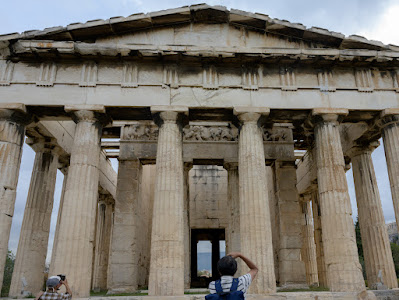30th April - On the Salar de Uyuni and Fish Island
Driving from the train cemetery it did not take long to get on to the salt flat. A remarkable place.
Uyuni Salt Flat is the largest in the world at 4,086 square miles and the salt crust in places is several metres thick, lying over liquid brine. It is almost perfectly flat with the exception of a few islands such as Isla de Incahuasi, also known as Isla de Pescado or Fish Island which are the remains of ancient volcanos that protruded above the surface of a prehistoric inland sea - Lake Minchin which dried up to produce the salt.
The sky was perfectly blue and completely cloudless and we could see views of very distant mountains. We drove on to the flat by the production area where the salt had been cut out and stacked up.
 |
| At the top of this picture you can see the trucks loading up salt. |
Pauli drove us over to Fish Island (named for its shape) and set us out a wonderful lunch. There were six of us tourists all together with an Australian, a Canadian and a guy from Belgium who was half English and half French. Pauli ate with his friends from the other tour companies.
Fish Island is covered in rocks made from a crumbly, coral like substance composed of fossils and algae. The only life existing in this part of the salar is the enormous cacti and some scrubby vegetation growing on the island. The cacti grow only one centimetre a year but some of them reach to 12 m and these are reckoned to be aged about one millenium.
 |
| The coral like rock |
 |
| Jeeps on the salt beyond the island |
 |
| Natural arch |
 |
| The thousand year old cactus |
If you have ever seen pictures of these flats before it is most likely they have been of people doing funny things with perspective. I actually found it quite difficult to do and I wish I had found somewhere to practise before I had gone.
Jumping shots are also very popular, and look better if you take the shadows out.
 |
| Or you can take a more zen approach |
 |
| No need to use a polariser here |
After he had gathered us together we drove on towards the edge of those mountains where we were to stop overnight.
We stayed in a salt hotel near a small place called San Juan. Yes it was actually constructed out of blocks of salt with a thick layer of coarse salt on the floor to act as carpet. The tables, chairs and bed bases were all made of salt. We had a really nice dinner with llama as the meat, like eating tough lamb, and then I went out to do a bit of star gazing. I was attempting to take a picture of the southern cross but it is difficult to make it out against the milky way with the stars trailing over the 6 minutes it took to take. A really strange fact - the plough in the southern hemisphere appears upside down.
 |
| Inside the salt hotel |
 |
| The milky way with the southern cross |
























Comments
Post a Comment